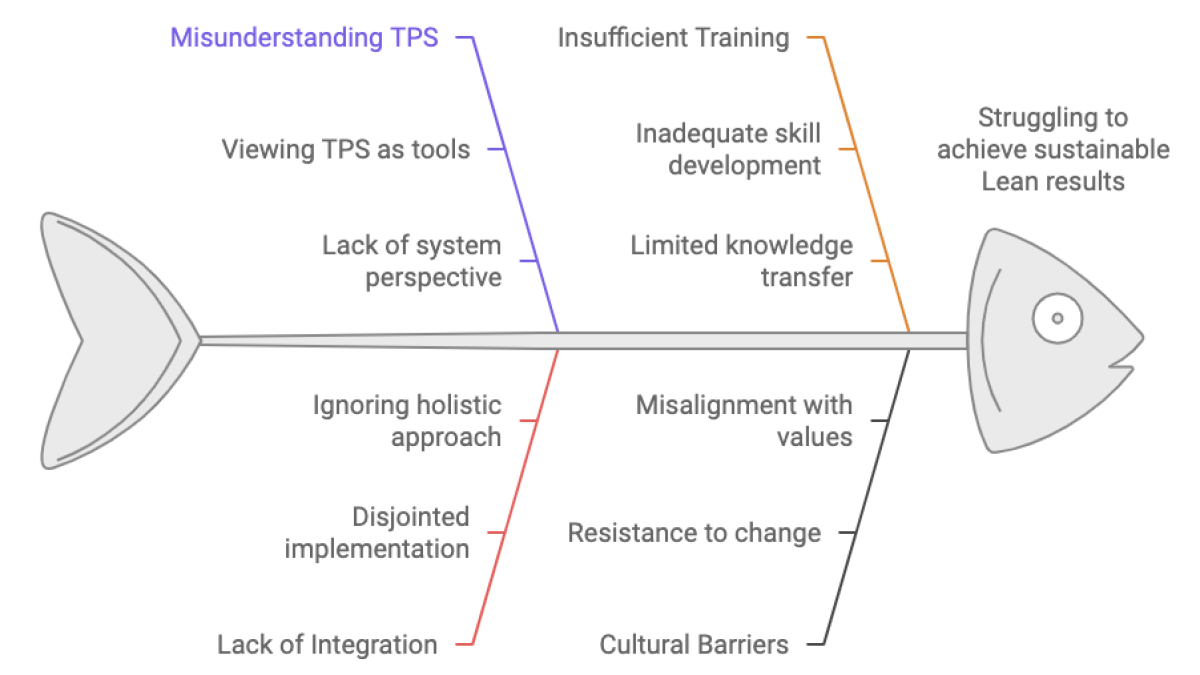Systemic Nature of the Toyota Production System

Beyond Tools: The Systemic Nature of the Toyota Production System
In the pursuit of operational excellence, many organizations attempt to implement Lean manufacturing tools and techniques derived from the Toyota Production System (TPS). However, most struggle to achieve sustainable results because they view TPS as a collection of individual improvement tools rather than what it truly is – an integrated system of principles, practices, and people working in harmony to create value.
The Misconception of Tool-Based Implementation
The allure of quick wins often leads companies to cherry-pick popular Lean tools like 5S, Kanban, or Visual Management systems. While these point improvements, known as Point Kaizen, can yield immediate results, they frequently lead to sub-optimization and fail to deliver lasting benefits. This tool-based approach misses the fundamental essence of TPS – its systemic nature.
Consider a manufacturing facility that implements Kanban cards without establishing standardized work or developing problem-solving capabilities. While inventory levels might temporarily improve, the system will likely break down when facing variability in demand or quality issues. This happens because Kanban is not just a card system; it's part of a broader Just-in-Time philosophy that requires stability, quality at the source, and engaged employees to function effectively.
Understanding TPS as an Integrated System
The Toyota Production System is often depicted as a house, with good reason. Like a house, TPS requires all its components to work together. The foundation of standardized work and stable processes supports the twin pillars of Just-in-Time and Jidoka (built-in quality). The roof represents the ultimate goal of customer satisfaction through high quality, low cost, and short lead times. At the center of this structure are people and continuous improvement culture.
Each element of TPS reinforces the others, creating a multiplier effect that cannot be achieved through isolated implementations:-
The Pitfalls of Point Kaizen
When organizations implement individual tools without understanding their interconnections, they often encounter several challenges:
Building a Systemic Approach
Successful implementation of TPS requires a holistic approach that recognizes the interdependencies between various elements. Organizations should focus on:
1. Foundation Building
Before implementing specific tools, establish basic stability through:
- - Standardized work processes
- 5S and workplace organization
- Basic problem-solving capabilities
- Team development and leadership engagement
2. System Integration
Once the foundation is solid, begin integrating system elements:
- - Pull systems aligned with customer demand
- Quality at the source mechanisms
- Flow creation and waste elimination
- Leader standard work to sustain improvements
3. Cultural Transformation
Throughout the implementation, focus on:
- - Developing people's capabilities
- Building problem-solving skills at all levels
- Creating a continuous improvement mindset
- Establishing effective communication channels
Measuring Success
The success of a systemic implementation can be measured through both leading and lagging indicators:
Leading Indicators:
- - Employee engagement levels
- Number of improvement suggestions
- Problem-solving activity
- Training hours completed
Lagging Indicators:
- - Lead time reduction
- Quality improvements
- Cost reduction
- Customer satisfaction scores
The Path Forward
Organizations seeking to implement TPS must resist the temptation of quick fixes through isolated tools. Instead, they should:
- 1. Develop a long-term vision for systematic implementation
2. Build internal capabilities before implementing tools
3. Focus on people development at all levels
4. Create supporting infrastructure for continuous improvement
5. Establish feedback loops to monitor progress
6. Maintain patience while building a sustainable system
Conclusion
The Toyota Production System is not a toolkit, but a comprehensive business system that requires full integration to deliver sustainable results. Organizations that understand and embrace this systemic nature are more likely to achieve lasting improvements in quality, cost, and delivery performance. While the journey may be longer than implementing individual tools, the results will be more sustainable and create genuine competitive advantage.
Success in Lean transformation comes not from the tools themselves, but from how they work together within an integrated system, supported by capable people and a culture of continuous improvement. Only by taking this holistic approach can organizations hope to replicate the remarkable success of Toyota and other companies that have successfully embraced true Lean thinking.
Categories: : Training
 Christopher Turner
Christopher Turner 